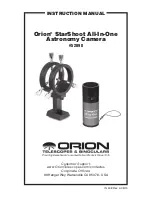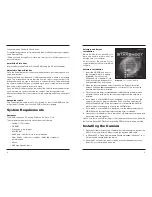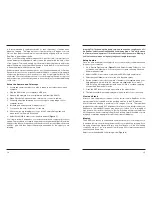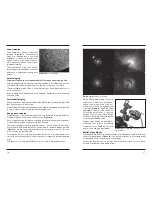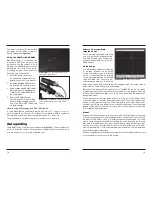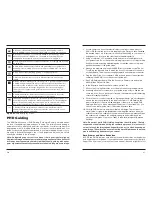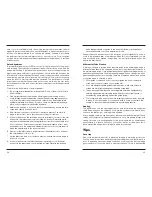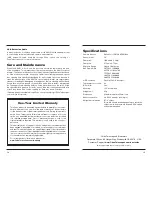
18
19
The 8mm focal length F1.0 wide field
lens gives a Field of View of approxi-
mately 30 degrees (
Figure 20).
using the SSAIO with ASCOM
ASCOM platform 5 or later and the
included ASCOM driver must be
installed to use the camera in PHD
Guiding. The ASCOM driver must also
be installed if you wish to use anoth-
er imaging program other than Orion
AstroCap such as MaximDL.
1. Install the native camera driv-
ers and device hardware per the
installation section of this manual.
2. Install the provided ASCOM driv-
ers from the CD Launcher menu.
3. Using supported ASCOM compat-
ible software, such as Nebulosity
or MaxIm DL, select ASCOM for
the camera type.
4. From the ASCOM Camera
Chooser, select Orion All-In-One
Camera. Adjust the gain if neces-
sary & turn ON or OFF 12bit mode
via the properties.
Note: If using PHD guiding turn OFF 12 Bit mode.
If using MaxmDL the capture will be in RAW format. To convert to color for-
mat first select Color->Convert Color. Next choose Generic RGB in the Select
Camera drop down menu. Next change the offset to X=1 and Y =0.
The white balance should now be set to complete color conversion.
Autoguiding
The SSAIO is also a fully functional autoguider (
Figure 21). The autoguider out-
put is on-board the camera, allowing the autoguider cable to connect directly
from the camera to your mount’s autoguider port.
Primary telescope/Main
Imaging Scope
Your main imaging scope will be used
with your main astro-imaging camera.
The main imaging scope can be virtu-
ally any scope suitable for your CCD or
DSLR camera.
Guide Scope
You will need an additional telescope
for guiding, referred to as a guide
scope. The guide scope is mounted
on top of, or beside the main imaging
scope. Adjustable guide scope tube
rings (available from Orion) are rec-
ommended and allow you to move the
guide scope around without moving the main imaging scope. The guide scope is
adjusted in the same fashion as a finder scope.
Because of the high resolution and accuracy of the SSAIO, you do not need a
large guide scope; any small refractor will serve well for this purpose. Separate
refractor optical tube assemblies, such as the Orion Short Tube 80, make excel-
lent guide scopes.
The only exception to using a guide scope is to is use an off-axis guider, which
is typically made for Schmidt-Cassegrain telescopes. The off-axis guider uses
a prism to intercept a small portion of the light path in front of the camera, thus
allowing the camera and guider to use the same telescope. Off-axis guiders
require a large amount of inward focus travel which is why they are only suitable
for Cassegrain type telescopes.
Mount
An equatorial mount with dual axis motors and a RJ-12 autoguide port is required.
Just about any equatorial mount equipped with an autoguide port will work with
the SSAIO. The SSAIO is “ST-4” compatible which uses the same pin out config-
uration as the first generation CCD autoguiders. Most computerized goto mounts
also have this autoguide port. For short exposure deep space photography (typi-
cally 45 seconds or less) the SSAIO can successfully guide with a computer-
ized altitude-azimuth or fork mounted telescope, popular among computerized
Schmidt-Cassegrain telescopes.
However, guided exposures longer than one minute in an altitude-azimuth mount
will cause field rotation to occur in the image.
Figure 21.
The
SSAIO setup for guiding
using the Orion Mini guider with helical
focuser.
Figure 22.
PHD Guiding software.
Figure 20:
The Orion Nebula as seen
through the Digital finder.

